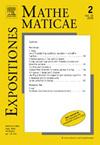Observations about the Lie algebra g2⊂so(7), associative 3-planes, and so(4) subalgebras
IF 0.8
4区 数学
Q2 MATHEMATICS
引用次数: 1
Abstract
We make several observations relating the Lie algebra , associative 3-planes, and subalgebras. Some are likely well-known but not easy to find in the literature, while other results are new. We show that an element cannot have rank 2, and if it has rank 4 then its kernel is an associative subspace. We prove a canonical form theorem for elements of . Given an associative 3-plane in , we construct a Lie subalgebra of that is isomorphic to . This subalgebra differs from other known constructions of subalgebras of determined by an associative 3-plane. These are results of an NSERC undergraduate research project. The paper is written so as to be accessible to a wide audience.
李代数g2∧so(7)、结合3平面和so(4)子代数的观察
我们对李代数g2∧so(7)、结合3-平面和so(4)子代数作了若干观察。有些可能是众所周知的,但不容易在文献中找到,而其他结果是新的。我们证明了一个元素X∈g2不能有秩2,如果它有秩4,那么它的核是一个结合子空间。我们证明了g2元素的一个标准形式定理。给定R7中的一个结合的3平面P,构造一个与so(4)同构的so(7)=Λ2(R7)的李子代数Θ(P)。这个so(4)子代数不同于其他已知的由结合3平面确定的so(7)的so(4)子代数的构造。这些是NSERC本科生研究项目的结果。这篇论文是为了让广大读者都能读懂而写的。
本文章由计算机程序翻译,如有差异,请以英文原文为准。
求助全文
约1分钟内获得全文
求助全文
来源期刊
CiteScore
1.30
自引率
0.00%
发文量
41
审稿时长
40 days
期刊介绍:
Our aim is to publish papers of interest to a wide mathematical audience. Our main interest is in expository articles that make high-level research results more widely accessible. In general, material submitted should be at least at the graduate level.Main articles must be written in such a way that a graduate-level research student interested in the topic of the paper can read them profitably. When the topic is quite specialized, or the main focus is a narrow research result, the paper is probably not appropriate for this journal. Most original research articles are not suitable for this journal, unless they have particularly broad appeal.Mathematical notes can be more focused than main articles. These should not simply be short research articles, but should address a mathematical question with reasonably broad appeal. Elementary solutions of elementary problems are typically not appropriate. Neither are overly technical papers, which should best be submitted to a specialized research journal.Clarity of exposition, accuracy of details and the relevance and interest of the subject matter will be the decisive factors in our acceptance of an article for publication. Submitted papers are subject to a quick overview before entering into a more detailed review process. All published papers have been refereed.

 求助内容:
求助内容: 应助结果提醒方式:
应助结果提醒方式:


